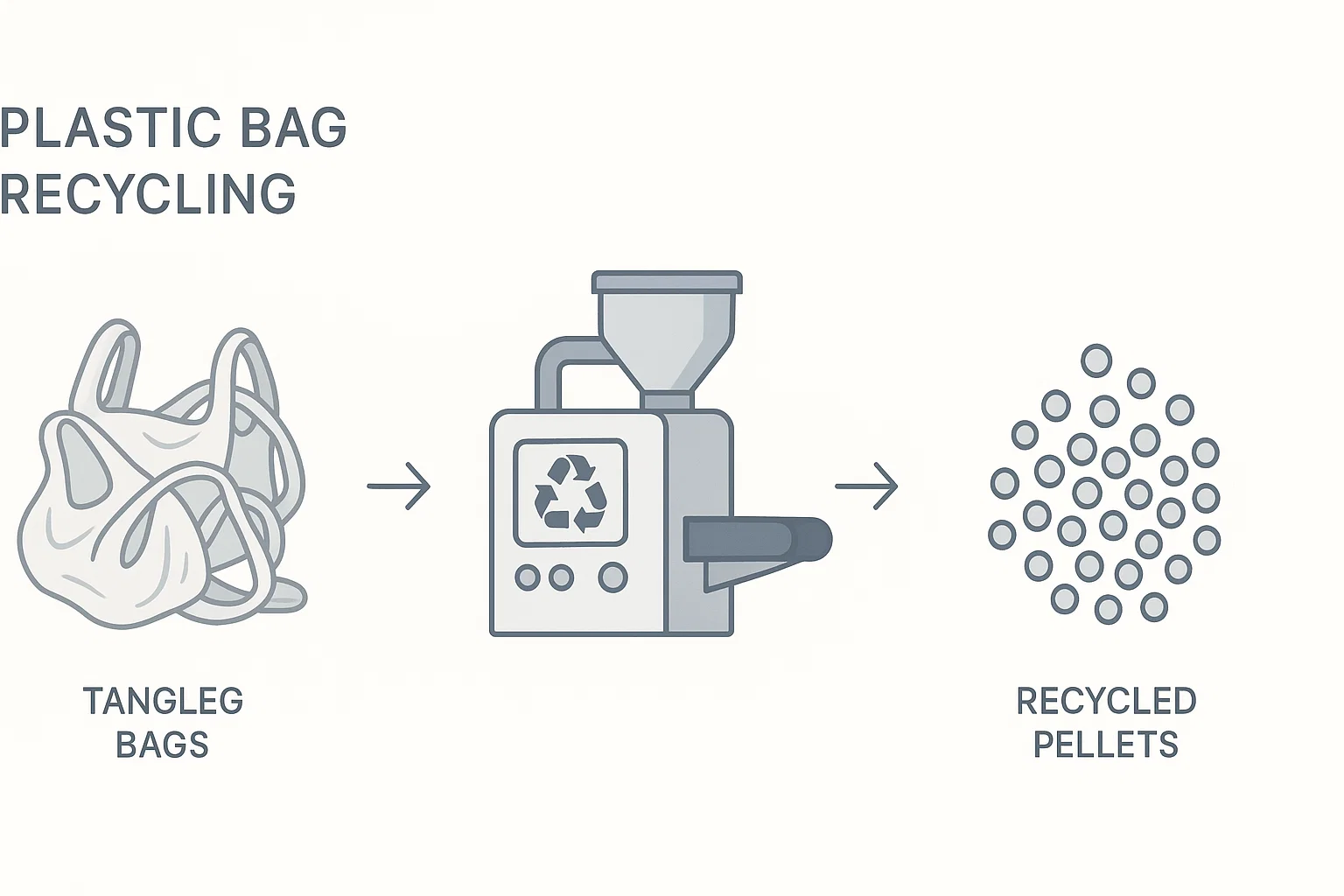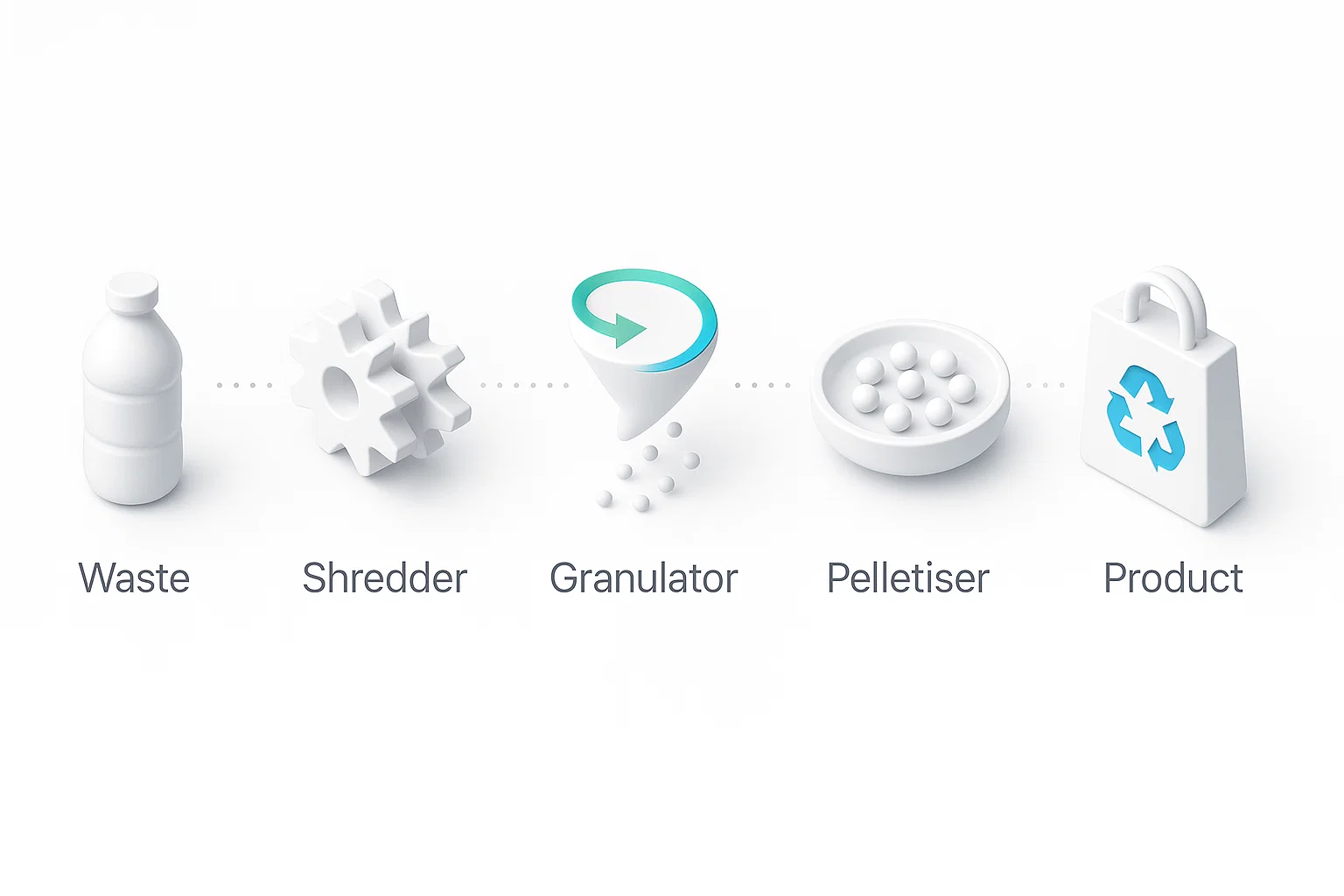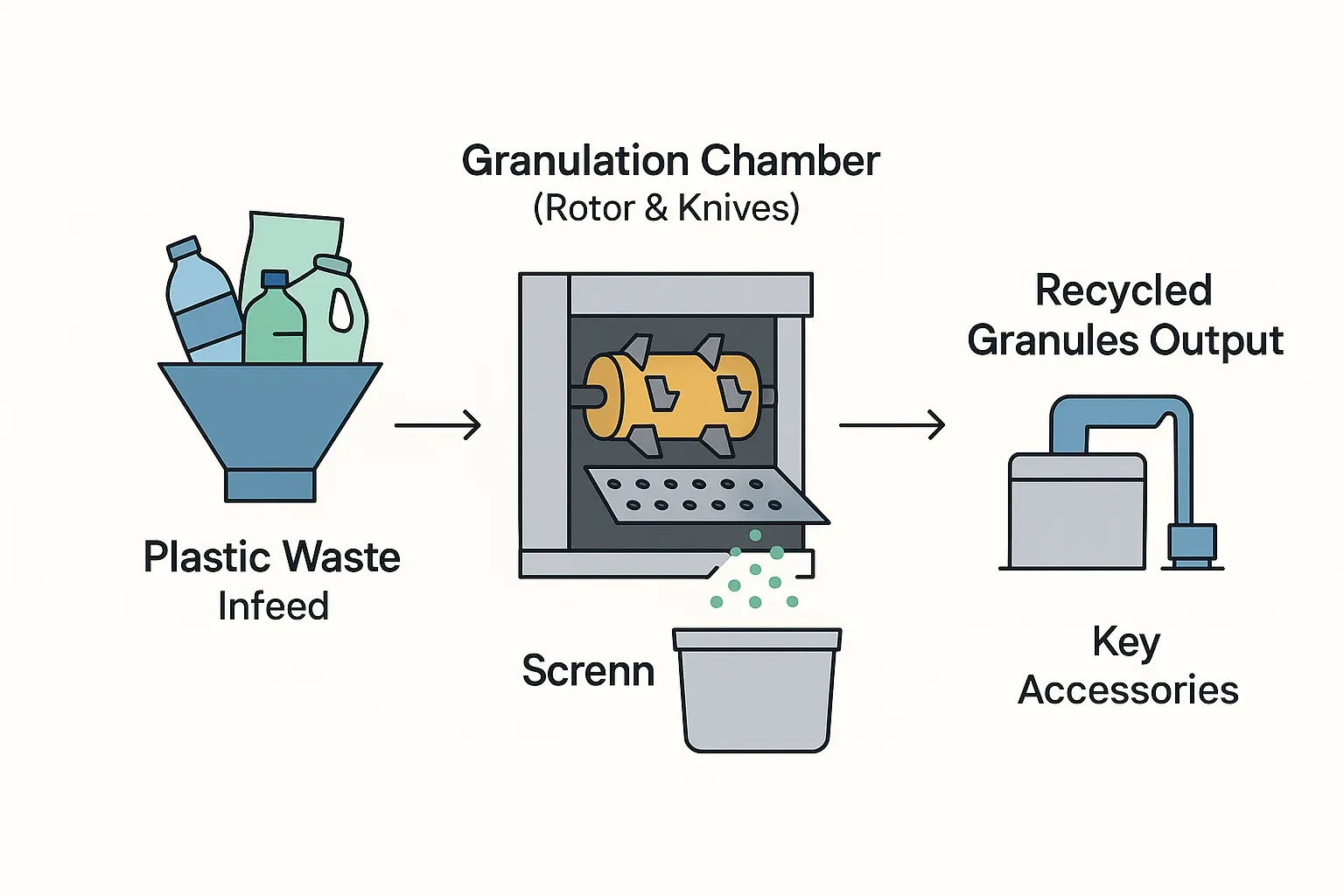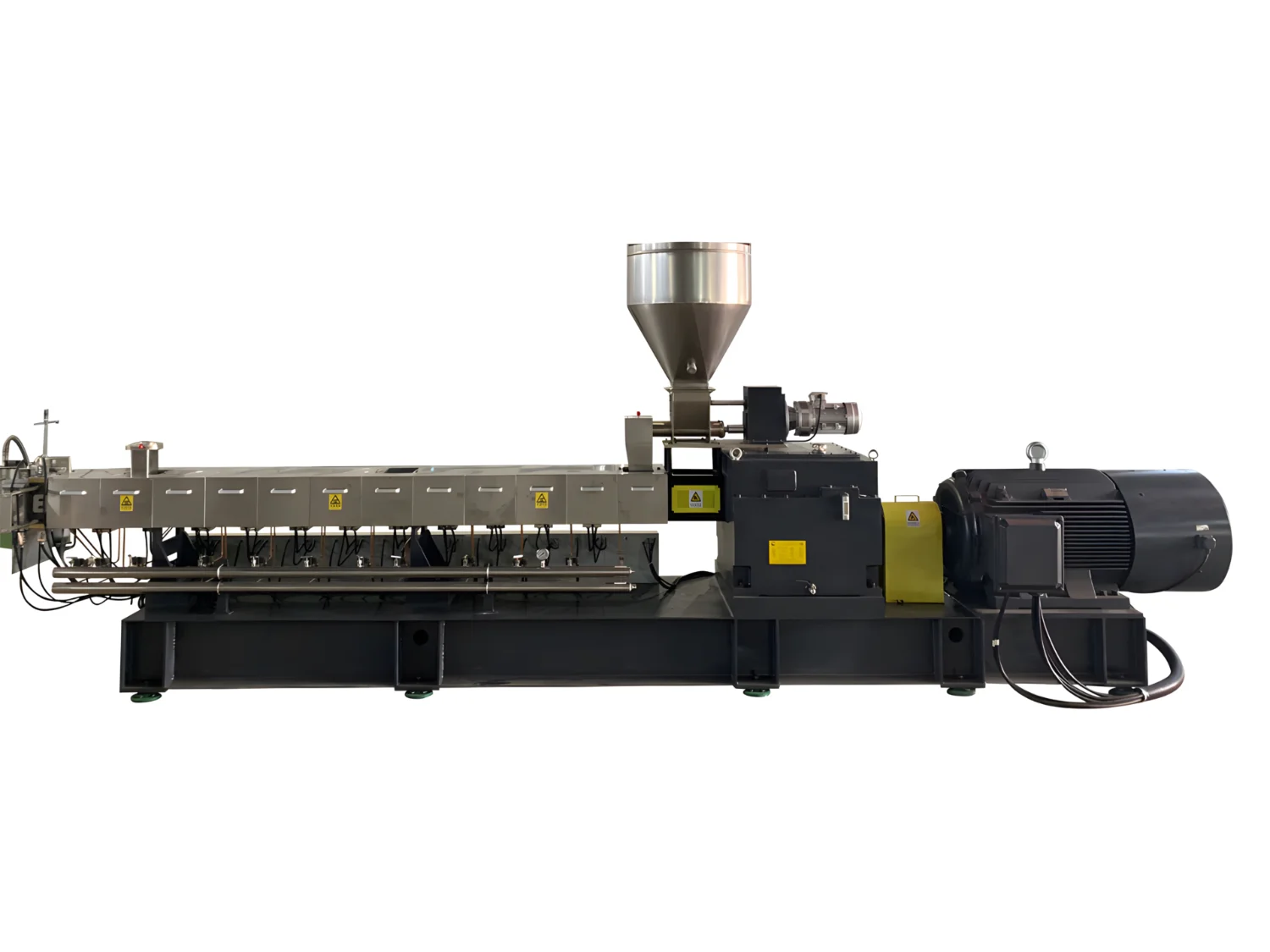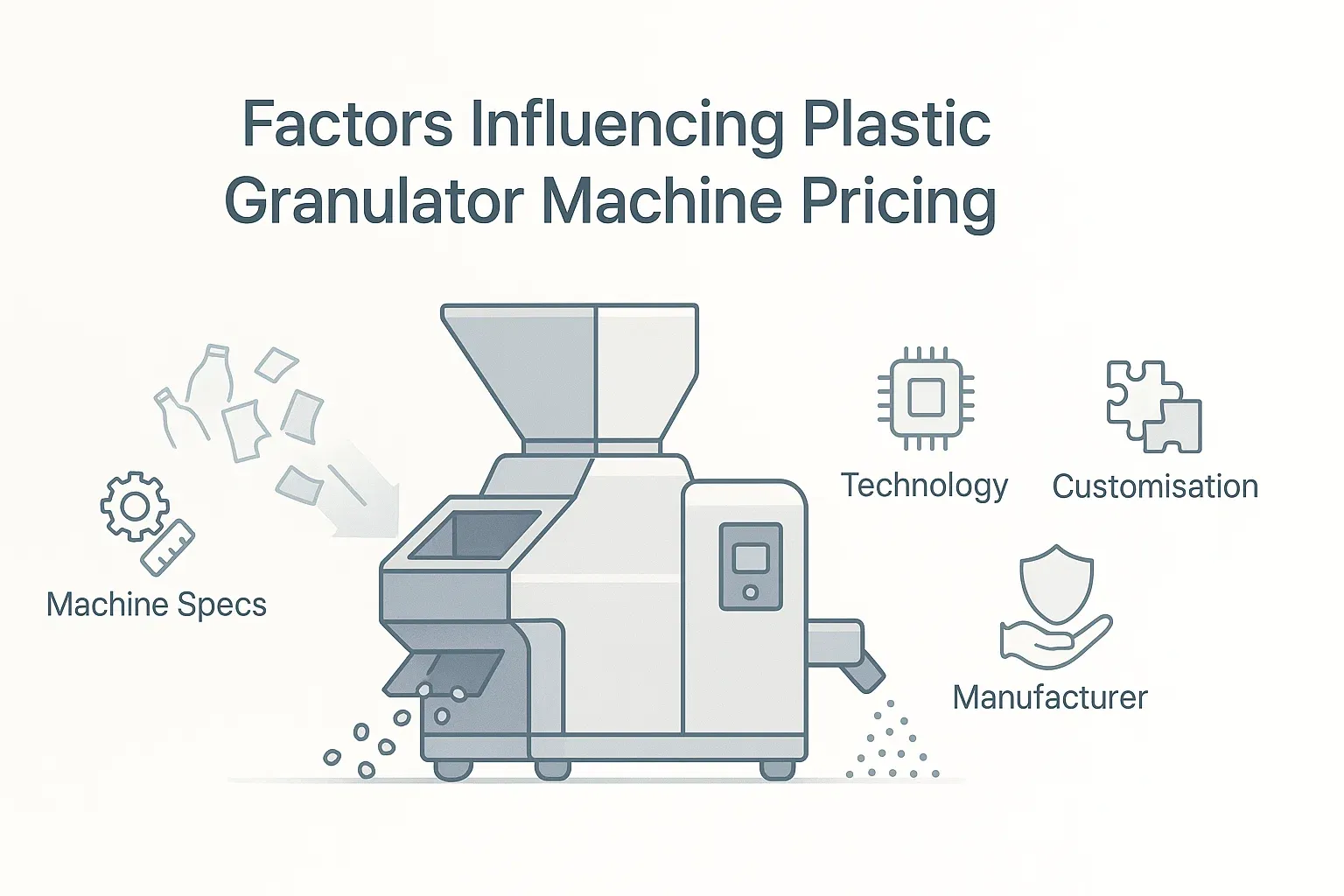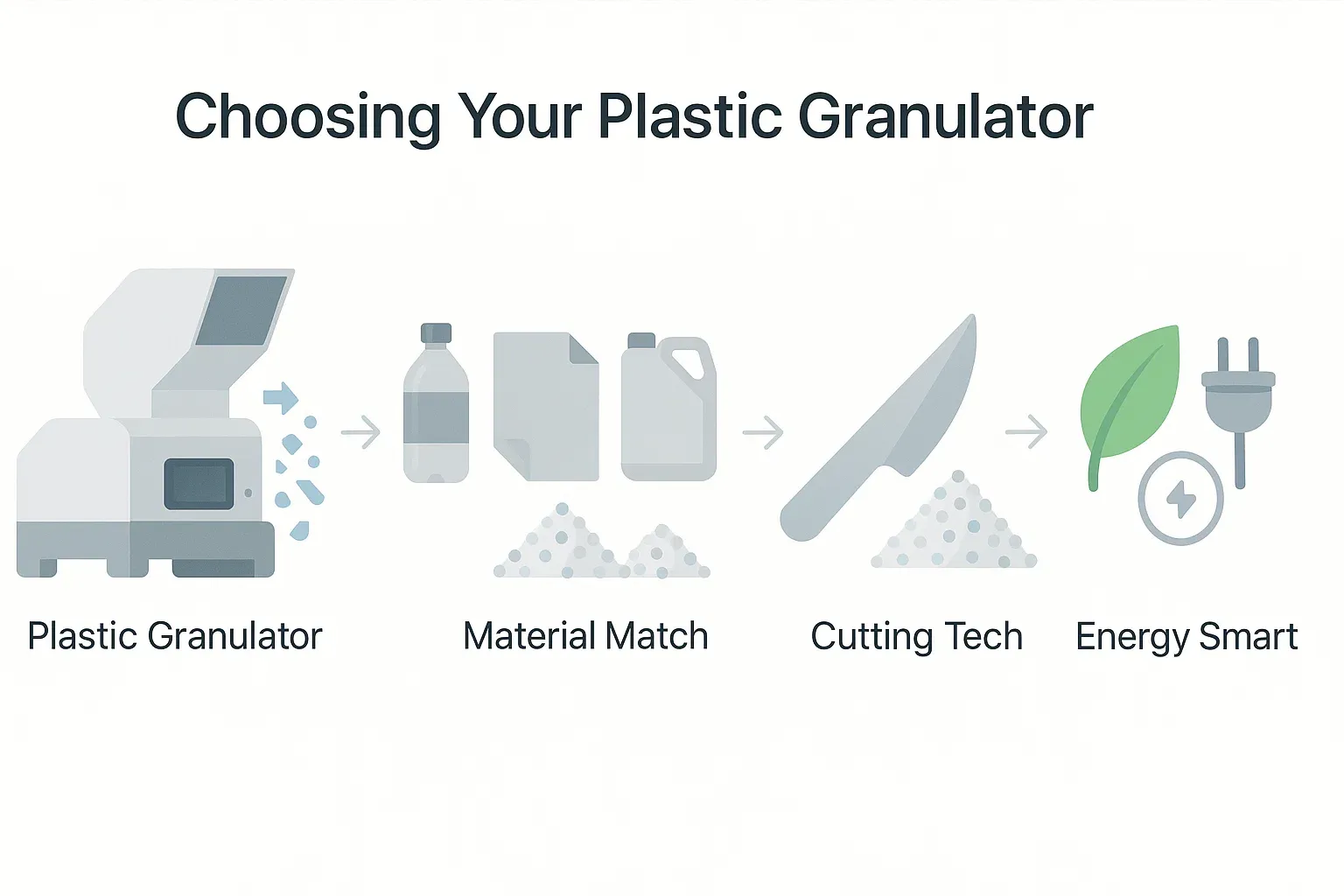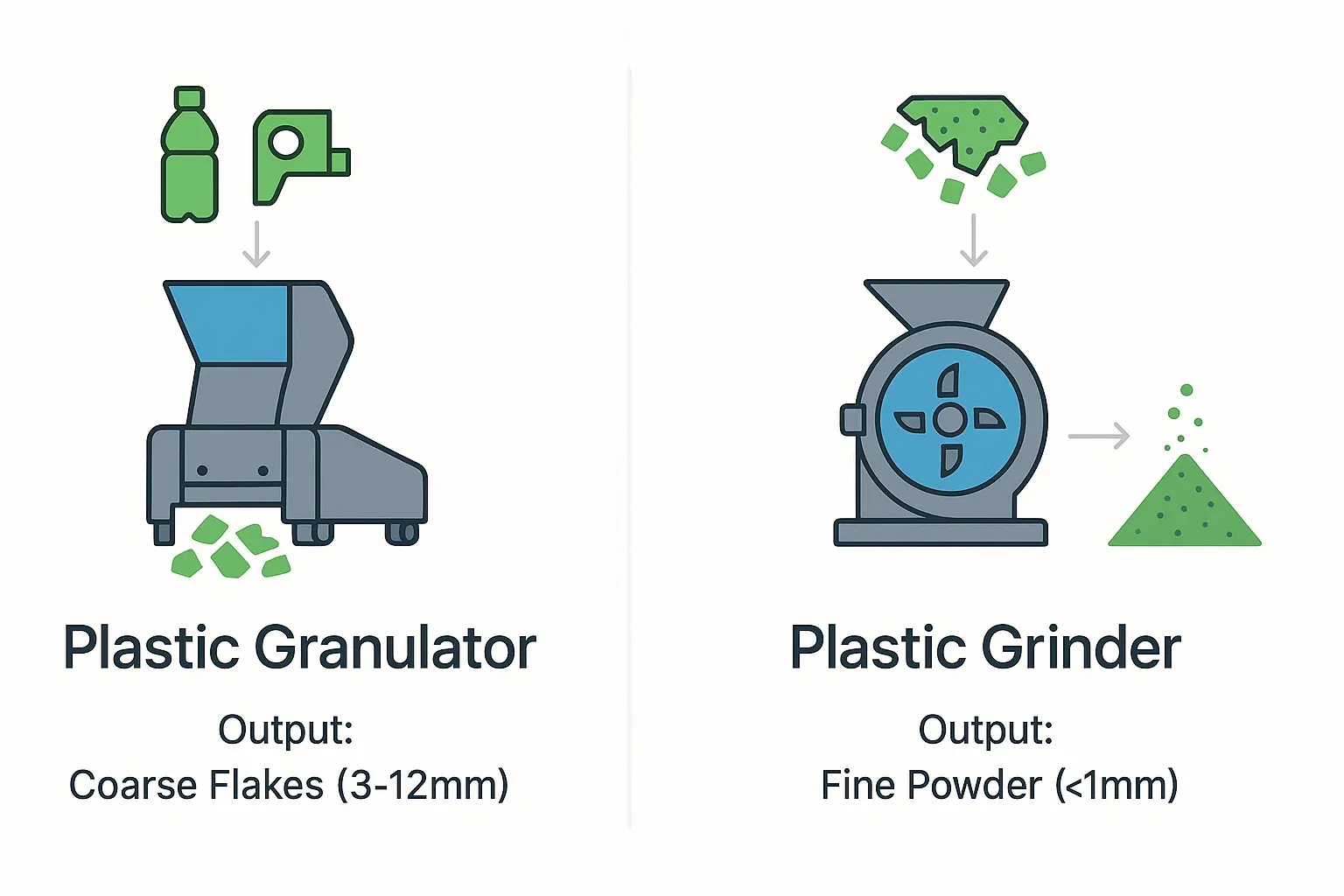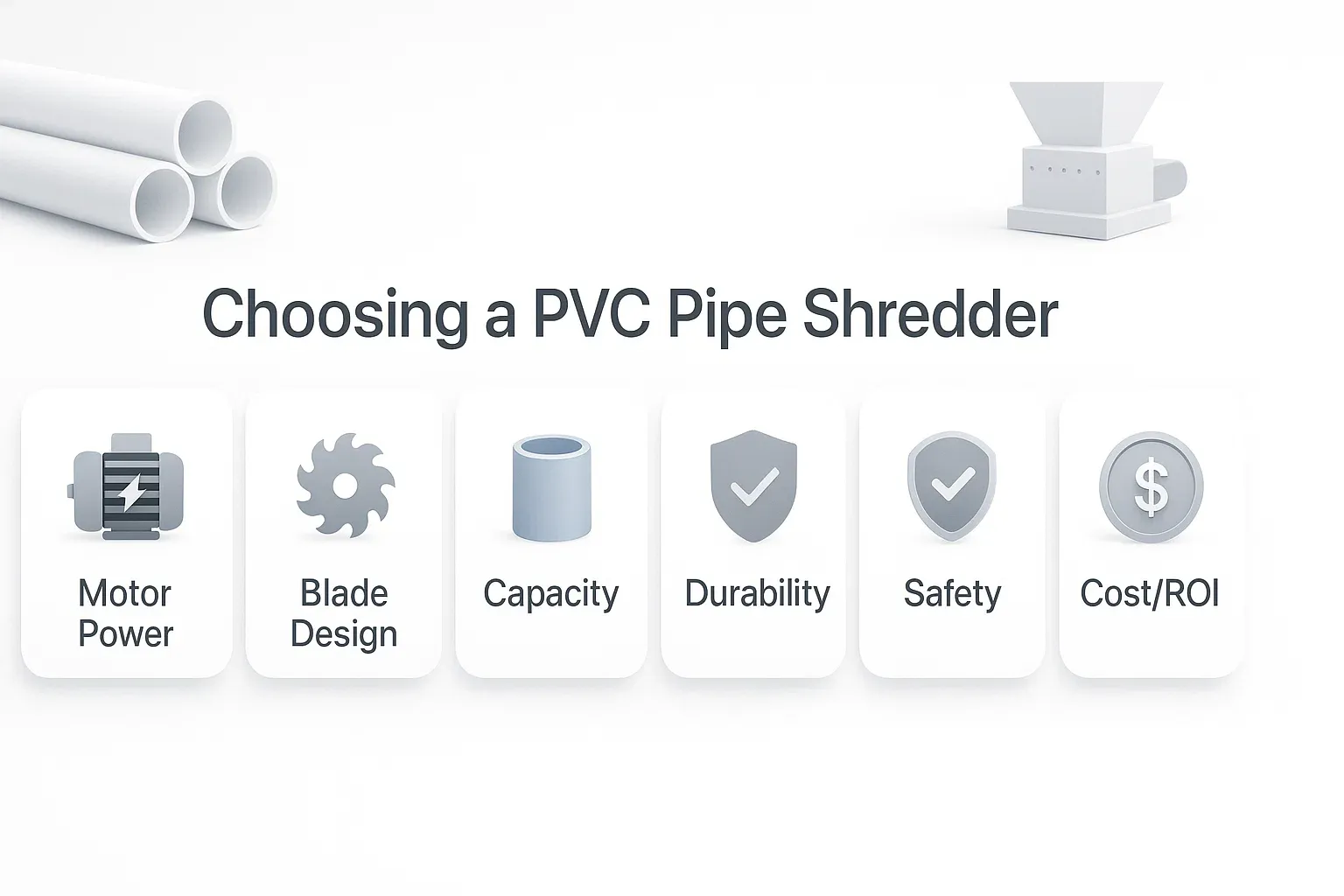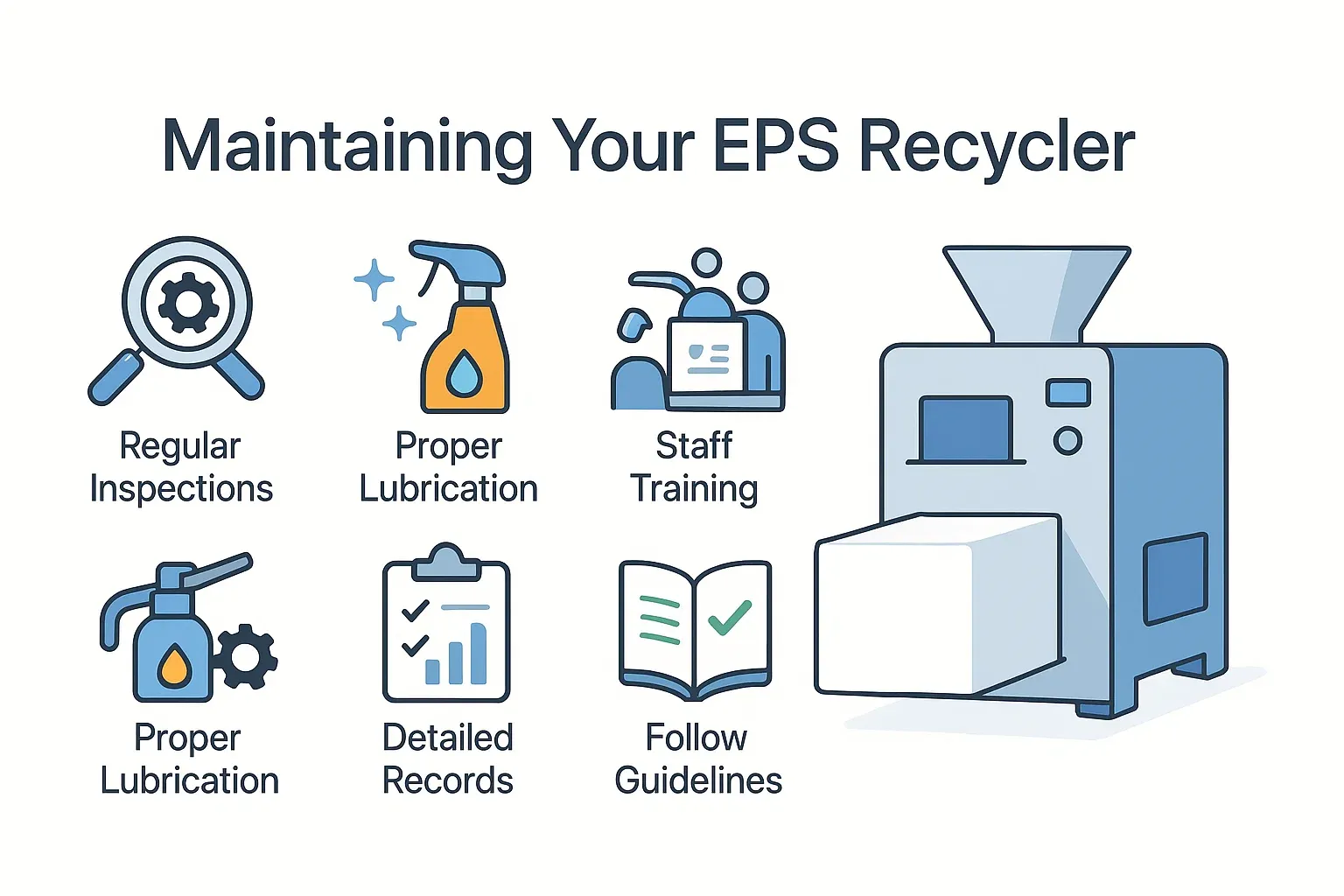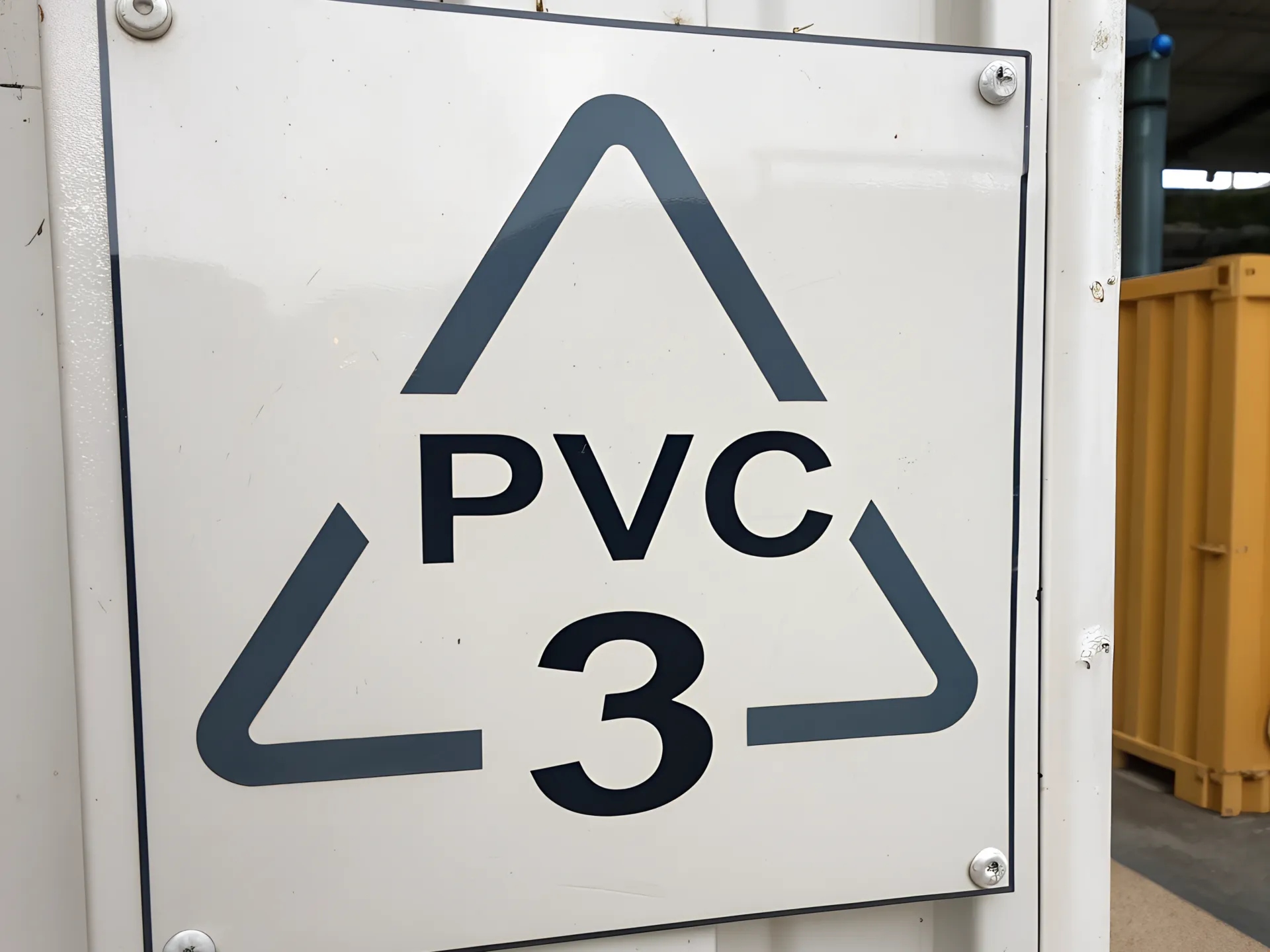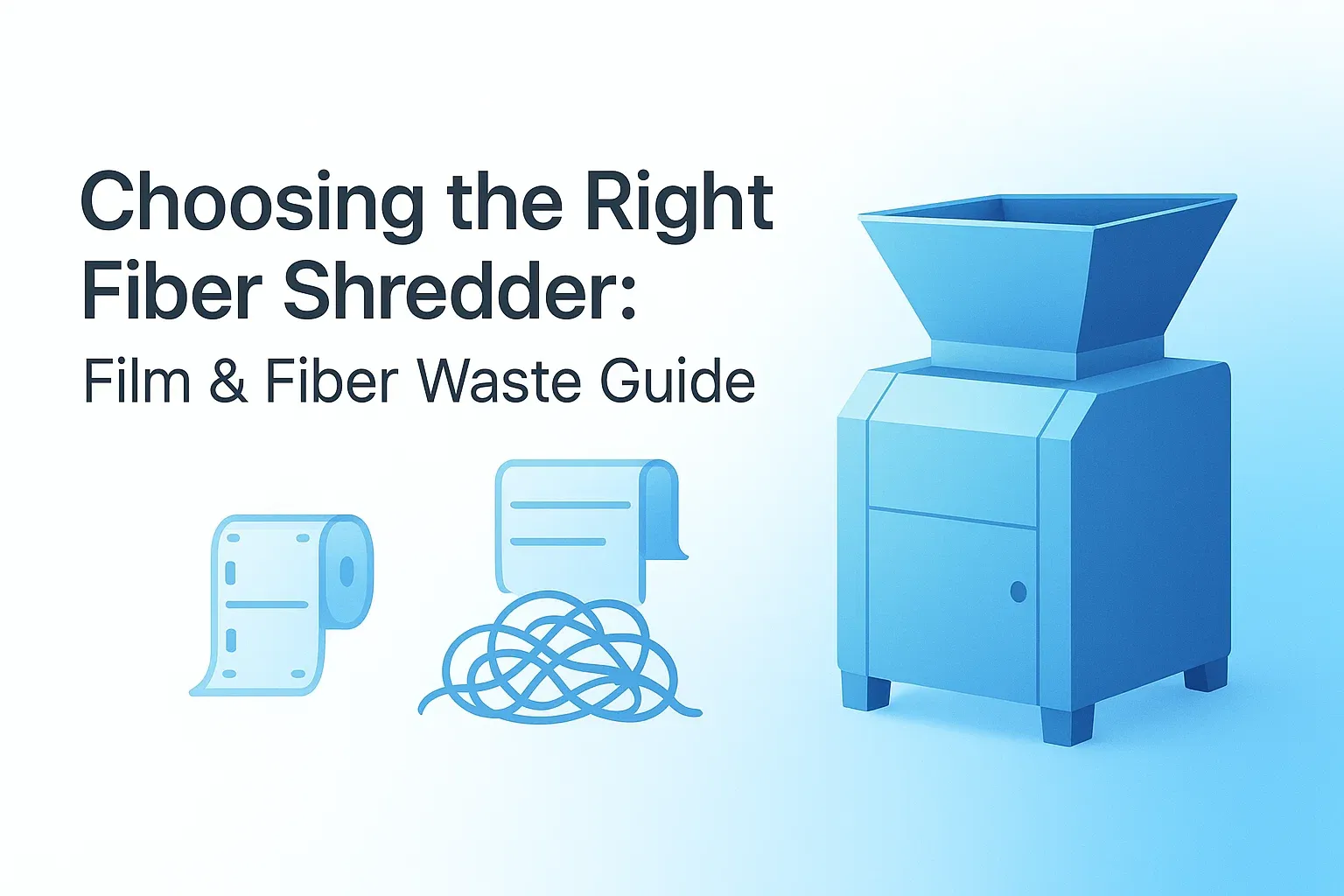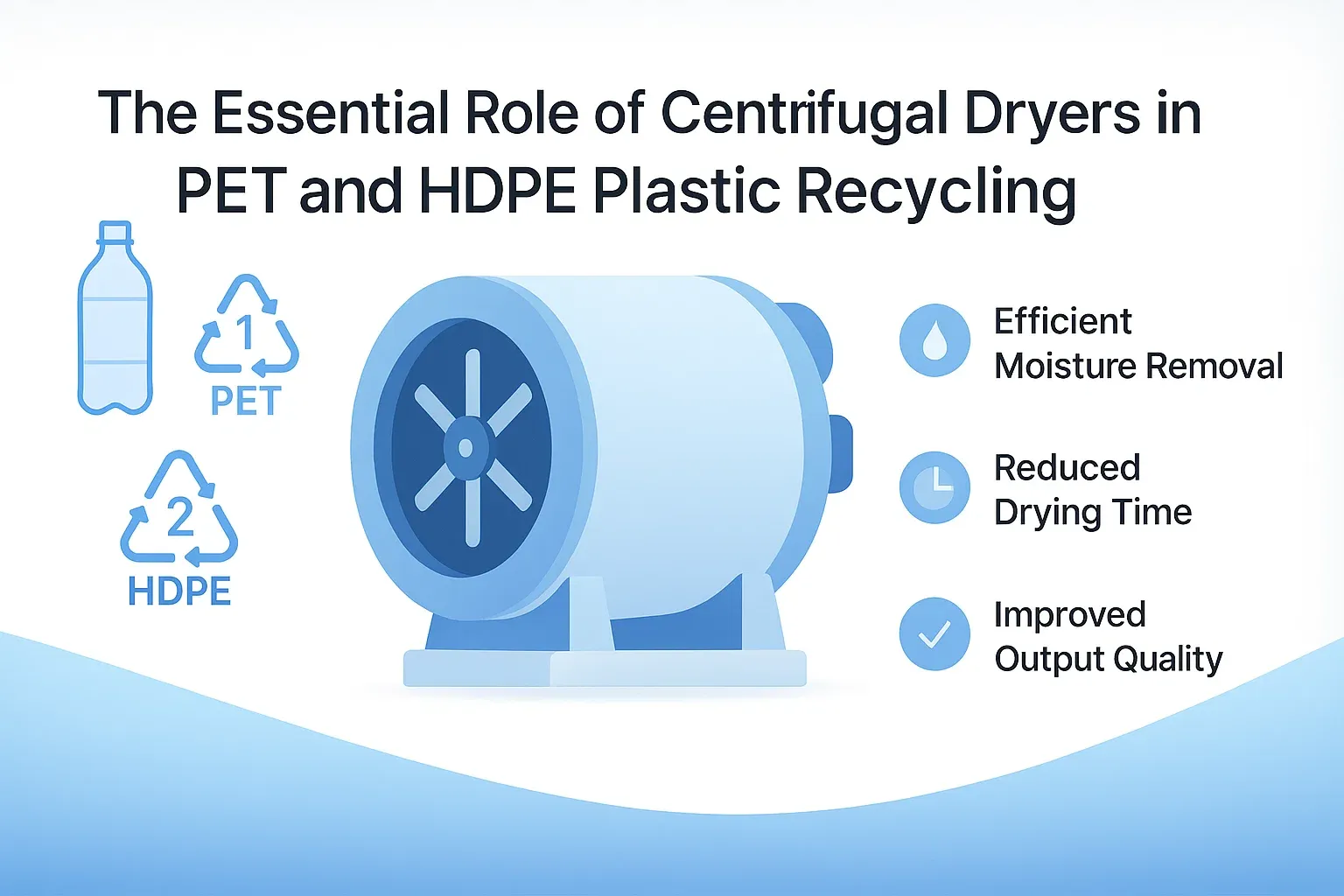Wiadomości o recyklingu
Poznaj różne rodzaje granulatorów do tworzyw sztucznych: Który z nich odpowiada Twoim potrzebom w zakresie recyklingu?
Globalna zmiana w kierunku gospodarki o obiegu zamkniętym umieściła recykling plastiku na czele zrównoważonych praktyk przemysłowych. Dla przedsiębiorstw zajmujących się przekształcaniem odpadów plastikowych w surowce nadające się do ponownego użycia, Granulator plastiku jest niezastąpionym elementem maszynerii. Te solidne systemy przetwarzają oczyszczony i często rozdrobniony lub stopiony plastik w jednolite peletki, które są następnie gotowe do ponownego wprowadzenia do procesów produkcyjnych.
Jednakże przy różnych typach Granulator plastikudostępne, każdy zaprojektowany do konkretnych zastosowań i rodzajów plastiku, wybór właściwego jest kluczowy dla optymalizacji operacji recyklingu, zapewnienia jakości peletu i maksymalizacji zwrotu z inwestycji. Ten kompleksowy przewodnik firmy Energycle przeprowadzi Cię przez różne Granulator plastiku technologie, które pomogą Ci określić, która z nich najlepiej odpowiada Twoim unikalnym potrzebom w zakresie recyklingu.
W Energycle rozumiemy krytyczną rolę, jaką wydajne i niezawodne maszyny odgrywają w Twoim sukcesie. Poznaj naszą ofertę najnowocześniejszych Granulatory do plastiku Zaprojektowano je tak, aby spełniały zróżnicowane potrzeby nowoczesnego przemysłu recyklingowego.
Dlaczego peletyzacja? Znaczenie jednorodności i jakości
Zanim zanurzymy się w rodzajach pelletizerów, warto przypomnieć, dlaczego pelletezacja jest kluczowym krokiem w recyklingu plastiku:
- Łatwość obsługi i przechowywania: Jednorodne granulki są znacznie łatwiejsze w obsłudze, transporcie i przechowywaniu w porównaniu do płatków lub proszków plastikowych o nieregularnych kształtach.
- Poprawiona spójność materiału: Granulowanie homogenizuje tworzywo sztuczne, co prowadzi do uzyskania bardziej jednolitego wskaźnika płynięcia (MFI) i lepszej wydajności w kolejnych procesach produkcyjnych.
- Zwiększona gęstość nasypowa: Pellet ma większą gęstość nasypową niż płatki, co pozwala ograniczyć koszty transportu i zwiększyć wydajność podawania materiału w wytłaczarkach.
- Mniej pyłu i drobnych cząsteczek: Dzięki temu operacje są czystsze, a straty materiałowe ograniczone do minimum.
- Zwiększona wartość rynkowa: Wysokiej jakości, jednorodny granulat osiąga lepszą cenę na rynku tworzyw sztucznych pochodzących z recyklingu.
Główne typy systemów granulacji tworzyw sztucznych
Granulator plastikus można ogólnie podzielić na kategorie w oparciu o mechanizm cięcia i miejsce, w którym odbywa się cięcie w stosunku do matrycy. Dwie podstawowe kategorie to Granulatory pasmowe I Granulatory Die-Face (w tym systemy podwodne i systemy pierścieni wodnych).
1. Granulatory pasmowe
Peletyzacja pasmowa to sprawdzona i wszechstronna metoda odpowiednia do szerokiej gamy polimerów, w szczególności tych wrażliwych na pękanie stopowe lub mających niższą wytrzymałość stopu.
Przepływ pracy:
- Wyrzucenie: Stopiony plastik jest wytłaczany przez głowicę matrycy, tworząc ciągłe pasma.
- Chłodzenie: Następnie pasma te są zazwyczaj chłodzone poprzez przepuszczenie ich przez kąpiel wodną lub chłodzenie powietrzem.
- Wysuszenie: Po schłodzeniu, resztki wody usuwa się z pasm za pomocą noża powietrznego lub urządzenia odwadniającego.
- Cięcie: Schłodzone i wysuszone pasma są podawane do jednostki granulującej, gdzie wirnik z wieloma nożami tnie je na cylindryczne lub sześcienne peletki o określonej długości.
Zalety granulatorów Strand:
- Wszechstronność: Nadaje się do szerokiej gamy tworzyw termoplastycznych, w tym materiałów wypełnionych i tworzyw konstrukcyjnych.
- Opłacalność: Ogólnie rzecz biorąc, linie do peletyzacji pasma charakteryzują się niższymi początkowymi kosztami inwestycyjnymi w porównaniu z systemami z matrycą czołową w przypadku niektórych wydajności.
- Dobra jakość peletu: Przy prawidłowej obsłudze możliwe jest wytwarzanie wyjątkowo jednorodnych peletów.
- Łatwiejsza konserwacja: Komora tnąca i noże są zazwyczaj łatwiej dostępne, co ułatwia czyszczenie i konserwację.
Rozważania dotyczące granulatorów pasmowych:
- Pracochłonne: Może wymagać większej uwagi operatora, szczególnie podczas rozruchu lub gdy pękną włókna.
- Wymagania dotyczące miejsca: Sekcje chłodząca i susząca mogą znacznie wydłużać powierzchnię linii.
- Drobne cząsteczki i pył: Istnieje możliwość powstania większej ilości drobnych cząstek i pyłu, jeśli pasma nie są odpowiednio chłodzone lub jeśli nożyce nie są dobrze konserwowane.
Idealne zastosowania:
- Operacje złożone.
- Recykling materiałów o mniejszej ścieralności.
- Przetwarzanie polimerów wrażliwych na ciepło.
- Mniejsze i średnie zakłady, gdzie wszechstronność ma kluczowe znaczenie.
2. Granulatory z matrycą czołową
W systemach peletyzacji die-face plastik jest cięty bezpośrednio na powierzchni matrycy wytłaczarki. Ta metoda jest często preferowana w przypadku większych przepustowości i przetwarzania materiałów, które są trudne do obróbki jako pasma. Istnieją dwa główne podtypy: granulatory Water-Ring i granulatory Underwater.
a) Granulatory pierścieniowo-wodne (WRP)
Przepływ pracy:
- Wyrzucenie: Stopiony polimer jest wytłaczany przez otwory matrycy.
- Cięcie: Obracające się noże przesuwają się po powierzchni matrycy, tnąc stopione pasma na peletki.
- Chłodzenie i transport: Bezpośrednio po przecięciu peletki są wyrzucane na zewnątrz za pomocą siły odśrodkowej do pierścienia wodnego, który je chłodzi i transportuje.
- Wysuszenie: Następnie granulat i woda są oddzielane w suszarce odśrodkowej.
Zalety granulatorów pierścieniowo-wodnych:
- Kompaktowa konstrukcja: Generalnie bardziej kompaktowe niż linie do peletyzacji pasm.
- Dobre dla poliolefin: Szczególnie dobrze nadaje się do materiałów takich jak polietylen (PE) i polipropylen (PP).
- Operacja automatyczna: Zwykle wymagają mniejszej ingerencji operatora niż peleciarki taśmowe.
- Jednolity kształt granulek: Produkuje peletki kuliste lub owalne, co może być korzystne w niektórych zastosowaniach.
Zagadnienia dotyczące granulatorów pierścieniowo-wodnych:
- Ograniczenia materiałowe: Może nie być odpowiedni do materiałów bardzo miękkich, lepkich lub wysoce ściernych.
- Naprężenie cieplne: Szybkie chłodzenie może czasami powodować naprężenia cieplne w niektórych polimerach.
Idealne zastosowania:
- Wysokoprzepustowy recykling PE i PP.
- Zastosowania, w których wymagany jest bardziej kulisty kształt granulatu.
- Działania, w których przestrzeń jest ograniczona.
b) Granulatory podwodne (UWP)
Przepływ pracy:
- Wyrzucenie: Stopiony polimer jest wytłaczany przez płytę matrycową bezpośrednio do komory z wodą hartowaną.
- Cięcie: Obracające się noże tną włókna polimerowe na peletki w momencie ich wydostania się z matrycy, a wszystko to pod wodą.
- Chłodzenie i transport: Woda chłodzi peletki i transportuje je w postaci zawiesiny do suszarki wirówkowej.
- Wysuszenie: Pellet oddziela się od wody i suszy.
Zalety granulatorów podwodnych:
- Doskonała jakość peletu: Produkuje niezwykle jednorodne, zazwyczaj kuliste peletki z minimalną ilością drobnych cząstek i aglomeratów.
- Radzi sobie z trudnymi materiałami: Doskonale nadaje się do szerokiej gamy tworzyw termoplastycznych, w tym tworzyw bardzo miękkich, lepkich, kruchych lub wrażliwych na temperaturę, a także do tworzyw o dużej zawartości wypełniaczy.
- Wysoka przepustowość: Możliwość bardzo wysokiej wydajności produkcyjnej.
- System zamknięty: Minimalizuje narażenie operatora na opary i pył.
- Stałe chłodzenie: Bezpośredni kontakt z wodą zapewnia szybkie i równomierne chłodzenie.
Rozważania dotyczące granulatorów podwodnych:
- Wyższa początkowa inwestycja: Zwykle najdroższy typ Granulator plastiku.
- Bardziej złożone działanie: Wymaga precyzyjnej kontroli temperatury i przepływu wody.
- Konserwacja: Mogą być trudniejsze w utrzymaniu, szczególnie płyta matrycowa i komora tnąca.
Idealne zastosowania:
- Operacje recyklingu na dużą skalę.
- Przetwarzanie szerokiej gamy polimerów, w tym trudnych w obróbce, takich jak PET, PA, TPU i biotworzywa.
- Zastosowania wymagające najwyższej jakości i jednorodności peletu.
- Produkcja mikropeletek.
Wybór właściwego granulatora plastiku dla Twoich potrzeb
Wybór optymalnego Granulator plastiku wymaga starannej oceny kilku czynników:
- Rodzaj przetwarzanego plastiku:
- Poliolefiny (PE, PP): Wszystkie systemy mogą sobie z tym poradzić, ale WRP i UWP są powszechne w przypadku dużych przepustowości. Granulatory pasmowe oferują wszechstronność dla różnych gatunków.
- Tworzywa sztuczne konstrukcyjne (PET, PA, PC, ABS): UWP wyróżniają się dzięki swojej zdolności do radzenia sobie z różnymi mocami stopu i zapewniania stałej jakości peletu. Granulatory pasmowe są również wykonalne, szczególnie w przypadku mniejszych partii lub określonych związków.
- Tworzywa sztuczne wrażliwe na ciepło (PCW, niektóre bioplastiki): UWP oferują delikatne i kontrolowane chłodzenie. Można również stosować granulatory pasmowe z odpowiednim chłodzeniem.
- Materiały o dużej zawartości wypełniaczy lub materiały ścierne: Urządzenia UWP są często preferowane ze względu na ich solidną konstrukcję, chociaż specjalnie zaprojektowane granulatory pasma również mogą okazać się odpowiednie.
- Wymagana przepustowość:
- Niskie do średniego: Urządzenia do granulacji włókien mogą być bardzo opłacalne.
- Średnia do wysokiej: Granulatory pierścieniowo-wodne zapewniają dobry kompromis między wydajnością i ceną.
- Bardzo wysoki: Najczęściej wybieranym rozwiązaniem są granulatory podwodne.
- Pożądana jakość i kształt peletu:
- Cylindryczny/sześcienny: Granulatory pasmowe.
- Sferyczny/owalny: Pelletyzatory pierścieniowe i podwodne. UWP zazwyczaj produkują najbardziej jednorodne kuliste peletki.
- Dostępny budżet:
- Koszt początkowy urządzeń do peletyzacji jest często najniższy.
- Granulatory pierścieniowo-wodne zaliczają się do urządzeń średniej klasy.
- Granulatory podwodne wymagają największej początkowej inwestycji, ale dzięki automatyzacji i wydajności mogą zapewnić niższe koszty eksploatacji w dłuższej perspektywie przy wysokiej przepustowości.
- Rozważania operacyjne:
- Dostępność miejsca: WRP i UWP są na ogół bardziej kompaktowe niż linie linkowe.
- Dostępność siły roboczej i poziom umiejętności: Linie splotowe mogą wymagać więcej ręcznej interwencji. Systemy Die-face są zazwyczaj bardziej zautomatyzowane.
- Wymagania konserwacyjne: Należy wziąć pod uwagę łatwość dostępu podczas czyszczenia, wymiany noży i konserwacji płyty matrycowej.
| Funkcja | Granulator pasmowy | Granulator pierścieniowo-wodny (WRP) | Granulator podwodny (UWP) |
| Akcja cięcia | Schłodzone pasma cięte przez obracające się noże | Stopione granulki cięte na powierzchni matrycy, chłodzone pierścieniem wodnym | Stopione granulki cięte na powierzchni matrycy pod wodą |
| Kształt granulek | Cylindryczny / Sześcienny | Sferyczny / Soczewkowy | Sferyczny / Owalny |
| Typowe materiały | Szeroki zakres, w tym wypełnione, wrażliwe | Poliolefiny (PE, PP), niektóre inne | Bardzo szeroki zakres, w tym lepkie, kruche, miękkie, PET, PA |
| Przepustowość | Niski do średniego | Średnia do wysokiej | Wysoki do bardzo wysokiego |
| Ślad stopy | Może być długi | Kompaktowy | Relatywnie kompaktowy |
| Automatyzacja | Niżej | Średnia do wysokiej | Wysoki |
| Koszt początkowy | Niżej | Średni | Wyższy |
| Jednorodność granulek | Dobry do bardzo dobrego | Dobry do bardzo dobrego | Doskonały |
| Kluczowa zaleta | Wszechstronność, niższy koszt początkowy | Dobry do poliolefin, kompaktowy | Najwyższa jakość, radzi sobie z trudnymi materiałami |
| Namysł | Zerwanie pasma, pracochłonne | Ograniczenia materiałowe (np. lepkość) | Wyższe koszty, bardziej skomplikowana obsługa |
Zaleta energetyczna
W Energycle nie sprzedajemy tylko maszyn; dostarczamy rozwiązania. Nasz zespół ekspertów posiada głęboką wiedzę techniczną na temat procesów recyklingu plastiku i Granulator plastiku technologia. Współpracujemy ściśle z naszymi klientami, w tym nabywcami sprzętu do recyklingu przemysłowego, inżynierami i profesjonalistami z pokrewnych sektorów, aby zrozumieć ich szczególne wyzwania i cele.
Niezależnie od tego, czy przetwarzasz folię pokonsumencką, sztywny przemiał czy złom przemysłowy, możemy pomóc Ci wybrać i wdrożyć Granulator plastiku system, który zapewnia optymalną wydajność, niezawodność i wartość. Nasz Granulatory do plastiku zostały zaprojektowane z myślą o trwałości, wydajności i łatwości obsługi, co gwarantuje uzyskanie najwyższej jakości poddanego recyklingowi granulatu.
Wniosek
Wybór właściwego Granulator plastiku jest decyzją krytyczną, która bezpośrednio wpływa na wydajność i rentowność Twoich operacji recyklingu plastiku. Rozumiejąc odrębne zalety i idealne zastosowania granulatorów pasmowych, pierścieniowo-wodnych i podwodnych, możesz dokonać świadomego wyboru, który będzie zgodny z Twoimi rodzajami materiałów, wymaganiami dotyczącymi przepustowości, specyfikacjami jakości i budżetem.
Podróż do zoptymalizowanego recyklingu plastiku zaczyna się od odpowiedniego sprzętu. Skontaktuj się z Energycle już dziś, aby omówić swoje Granulator plastiku potrzeby i odkryj, w jaki sposób nasze innowacyjne rozwiązania mogą pomóc Twojej firmie rozwijać się w gospodarce o obiegu zamkniętym. Naszym zobowiązaniem jest dostarczanie Ci maszyn, które nie tylko spełniają, ale przekraczają Twoje oczekiwania, przyczyniając się do bardziej zrównoważonej przyszłości, jeden pelet na raz.
Dekodowanie kodu plastiku 3: Twój przewodnik po zrozumieniu PVC i jego odpowiedzialnym zarządzaniu
Zauważyłeś kiedyś spód plastikowego produktu, zobaczyłeś strzelające strzałki z numerem "3" w środku i zastanawiałeś się, co to oznacza? To mały symbol to klucz do identyfikacji Poliwinylochlorometanu, powszechnie znanego jako PVC. Zrozumienie tego wszechstronnego, ale złożonego plastiku jest kluczowe dla podejmowania świadomych decyzji dotyczących jego użycia, recyklingu i utylizacji. Zajmijmy się, co oznacza kod plastiku 3 i jak możemy odpowiedzialnie postępować z PVC, aby chronić nasze zdrowie i środowisko.
Poznaj PVC (Kodeks recyklingu 3)
Poliwinylochlorometan, lub PVC, wyróżnia się w świecie plastików. To elastyczny materiał, który występuje w dwóch głównych formach:
- Twardy PVC: Silny, wytrzymały i odporny na warunki atmosferyczne, sztywny PVC jest podstawowym materiałem w budownictwie. Znajdziesz go w ramach okiennych, rurach, rynnach deszczowych i elewacjach. Jest również używany do codziennych przedmiotów, takich jak karty kredytowe i karty podarunkowe.
- Elastyczny PVC: Poprzez dodanie plastyfikatorów, PVC może zostać przekształcone w miękki, giętki materiał. Ta forma jest stosowana w szerokiej gamie produktów, w tym izolacji kabli elektrycznych, rurkach i torbach medycznych, nadmuchiwanych zabawkach do basenu, zasłonach prysznicowych i niektórych rodzajach odzieży i tapicerki.
Numer "3" w symbolu recyklingu to kod identyfikacyjny reszty dla PVC. System ten został opracowany, aby pomóc recyklerom odróżniać różne typy plastików, co jest kluczowym krokiem w procesie recyklingu.
Wyzwania: Dlaczego Recykling PVC Nie Jest Zawsze Prosty
Podczas gdy symbol recyklingu może sugerować prostą ścieżkę do nowego życia dla produktów z PVC, rzeczywistość jest bardziej złożona. Recykling PVC napotyka kilka istotnych wyzwań:
- Wysoka zawartość chloru: PVC zawiera wysoki procent chloru (około 57% wagowo). Gdy PVC jest topione podczas recyklingu lub nieprawidłowo spalane, chlor ten może prowadzić do tworzenia się szkodliwych substancji, takich jak chlorowodór (żrący kwas) i dioksyny.
- Różnorodność dodatków: Aby uzyskać różnorodne właściwości, PVC jest często mieszany z szeregiem dodatków. Mogą to być:
- Plastyfikatory (np. ftalany): Stosowany do nadawania elastyczności PVC.
- Stabilizatory (historycznie obejmujące ołów lub kadm, obecnie często związki na bazie cyny lub związki organiczne): Aby zapobiec degradacji pod wpływem ciepła i światła.
- Wypełniacze i pigmenty. Dodatki te mogą utrudniać proces recyklingu, gdyż wpływają na jakość materiału poddanego recyklingowi, a także mogą uwalniać szkodliwe substancje chemiczne w przypadku niewłaściwego obchodzenia się z nimi.
- Zanieczyszczenie: Odpady z tworzywa PVC mogą łatwo ulec zanieczyszczeniu innymi tworzywami sztucznymi lub materiałami, co utrudnia osiągnięcie czystości niezbędnej do wysokiej jakości recyklingu.
- Niska akceptacja w programach odbioru przy krawężniku: Z powodu tych złożoności, wiele programów recyklingu z kurbside nie akceptuje PVC. Oznacza to, że wiele z niego, niestety, trafia do wysypisk śmieci, jeśli konsumenci nie są świadomi alternatywnych sposobów utylizacji.
Zarówno aspekty środowiskowe, jak i zdrowotne: Dlaczego Odpowiedzialne Zarządzanie PVC Jest Ważne
Wyzwania związane z recyklingiem PVC są ściśle powiązane z jego potencjalnym wpływem na środowisko i zdrowie w całym cyklu życia – od produkcji do utylizacji:
- Toksyczne emisje podczas produkcji i utylizacji: Produkcja PVC wiąże się z monomerem chlorku winylu (VCM), znanym ludzkim czynnikiem rakotwórczym. Jeśli PVC zostanie spalone, może uwolnić wysoce toksyczne związki, takie jak dioksyny I furanyDioksyny to trwałe zanieczyszczenia organiczne, które mogą gromadzić się w łańcuchu pokarmowym i są powiązane z rakiem, problemami rozrodczymi i rozwojowymi, uszkodzeniem układu odpornościowego i zakłóceniami hormonalnymi.
- Dodatki szkodliwe:
- Ftalany: Niektóre ftalany, często używane w elastycznym PVC, są dysruptorami endokrynnymi, co oznacza, że mogą zakłócać systemy hormonalne organizmu. Ekspozycja na nie jest związana z problemami rozwojowymi, problemami reprodukcyjnymi oraz zwiększonym ryzykiem alergii i astmy.
- Metale ciężkie: Mimo że ich stosowanie zmniejszyło się, starsze produkty z PVC mogą zawierać metale ciężkie, takie jak ołów i kadm, będące stabilizatorami, które są toksyczne i mogą przedostawać się do środowiska.
- Zanieczyszczenie mikroplastikiem: Podobnie jak wszystkie tworzywa sztuczne, PVC z czasem może rozpaść się na mikroplastik, który przyczynia się do zanieczyszczenia naszych gleb, wód i oceanów, a także może przedostać się do łańcucha pokarmowego.
Zrozumienie tych zagrożeń pokazuje, dlaczego właściwe obchodzenie się z PVC i jego utylizacja mają tak duże znaczenie.
Prawidłowa utylizacja i recykling PVC
Co zatem należy zrobić z produktami z PVC, gdy już ich nie potrzebujesz? Oto jak podejść do tego odpowiedzialnie:
- Najpierw sprawdź lokalne wytyczne dotyczące recyklingu: To zawsze jest najważniejszy krok. Możliwości recyklingu różnią się znacząco w zależności od gminy.
- Jak sprawdzić: Odwiedź stronę internetową urzędu miasta lub powiatu. Szukaj szczegółowej listy akceptowanych plastików lub przewodnika recyklingowego. W niektórych regionach dostępna jest dedykowana linia telefoniczna (np. 1-800-CLEANUP w USA) lub narzędzia do wyszukiwania online (np. Earth911.com, RecycleNation.com), które pozwalają wyszukiwać materiały według kodu pocztowego.
- Znajdź specjalistyczne zakłady recyklingu PVC: Jeśli lokalny program z kurbside nie akceptuje PVC (co jest powszechne), nie rezygnuj! Specjalistyczne zakłady recyklingowe są czasami wyposażone w sprzęt do jego przetwarzania.
- Co je wyróżnia? Te zakłady często mają zaawansowane technologie sortowania, aby oddzielić PVC od innych tworzyw sztucznych i zanieczyszczeń. Mogą stosować mechaniczne procesy recyklingu dostosowane do PVC, które obejmują mielenie, topienie i reformowanie plastiku, a nawet metody recyklingu chemicznego. Są również lepiej wyposażone do zarządzania potencjalnie szkodliwymi substancjami związanymi z PVC.
- Poznaj programy odbioru i darowizny:
- Niektórzy producenci lub sprzedawcy detaliczni, szczególnie w branży budowlanej (np. zajmujący się rurami lub ramami okiennymi), mogą prowadzić programy odbioru starych produktów z tworzywa PVC.
- Jeśli elementy z tworzywa PVC, takie jak rury czy siding winylowy, są w dobrym stanie, rozważ przekazanie ich organizacjom przyjmującym używane materiały budowlane, takim jak Habitat for Humanity ReStores.
- Alternatywne Metody Utylizacji – Kiedy Recykling Nie Jest Możliwy: Jeżeli nie masz możliwości recyklingu, ostatnią deską ratunku jest utylizacja.
- Unikaj przypalania: Nigdy nie należy palić produktów z PVC w ognisku na podwórku lub w niekontrolowanym miejscu, ze względu na uwalnianie się toksycznych oparów.
- Odpowiedzialne składowanie odpadów: Jeśli jedyną opcją jest wysypisko śmieci, upewnij się, że jest to robione zgodnie z lokalnymi przepisami dotyczącymi zarządzania odpadami. Choć nie jest to idealne ze względu na potencjalne przenikanie dodatków w czasie, jest lepsze niż niewłaściwe wyrzucanie. Głównym celem powinno być zawsze odwrócenie PVC od wysypisk.
Innowacje i przyszłość recyklingu PVC
Pomimo wyzwań podejmowane są działania mające na celu udoskonalenie recyklingu PVC i uczynienie go bardziej zrównoważonym:
- Postęp w recyklingu mechanicznym: Udoskonalenie technologii sortowania, czyszczenia i przetwarzania przyczynia się do uzyskania wyższej jakości przetworzonego PVC z niektórych strumieni odpadów.
- Technologie recyklingu chemicznego: Te powstające technologie mają na celu rozbicie PVC na jego składniki chemiczne, które następnie mogą być wykorzystane do wytworzenia nowego PVC o jakości dziewiczej lub innych cennych chemikaliów. Przykłady obejmują:
- Piroliza: Ogrzewanie tworzyw sztucznych w warunkach beztlenowych.
- Gazyfikacja: Przetwarzanie tworzyw sztucznych w gaz syntezowy.
- Rozpuszczanie na bazie rozpuszczalnika (podobnie jak proces VinyLoop®, choć jego status operacyjny może być różny): Proces ten rozpuszcza PVC z odpadów mieszanych, a następnie wytrąca go jako czysty materiał z recyklingu. Choć obiecujące, wiele technologii recyklingu chemicznego jest nadal w fazie rozwoju, stając przed wyzwaniami w zakresie skalowalności, opłacalności i zapewnienia prawdziwie cyrkularnej korzyści dla środowiska (zamiast po prostu przekształcania plastiku w paliwo, co nie jest prawdziwym recyklingiem).
- Inicjatywy branżowe: Programy takie jak VinylPlus® w Europie mają na celu zwiększenie zbiórki i recyklingu odpadów z PVC oraz promowanie wykorzystania przetworzonego PVC.
Te innowacje dają nadzieję na stworzenie gospodarki o obiegu zamkniętym dla PVC, ale wymagają ciągłych inwestycji, badań i polityki wsparcia.
Twoja rola w zrównoważonej przyszłości
Dzięki rozpoznaniu kodu recyklingowego 3 i zrozumieniu specyficznych uwag dotyczących PVC, już podjąłeś pozytywny krok. Oto, jak możesz kontynuować różnicę:
- Bądź świadomym konsumentem: Przed dokonaniem zakupu należy wziąć pod uwagę materiały, z których wykonane są produkty, a także opcje dotyczące końca ich cyklu życia.
- Ogranicz i wykorzystaj ponownie: Jeśli to możliwe, zmniejsz zależność od jednorazowych plastikowych przedmiotów. Wybierz trwałe, wielokrotnego użytku alternatywy.
- Utylizuj odpowiedzialnie: Zawsze przestrzegaj lokalnych wytycznych dotyczących recyklingu i utylizacji odpadów. Wspieraj lepszą infrastrukturę recyklingu w swojej społeczności, jeśli opcje są ograniczone.
- Pozostań ciekawy: Zdobywaj wiedzę na temat recyklingu tworzyw sztucznych i zrównoważonych praktyk gospodarowania odpadami.
Odpowiedzialne zarządzanie PVC to wspólny wysiłek. Uzbrajając się w wiedzę i podejmując świadome działania, możemy przyczynić się do zdrowszej planety i bardziej zrównoważonego podejścia do odpadów.
W świecie recyklingu tworzyw sztucznych wilgoć jest stałym wyzwaniem. Efektywne suszenie tworzyw sztucznych, takich jak PET (politereftalan etylenu) i HDPE (polietylen o dużej gęstości) ma kluczowe znaczenie dla produkcji wysokiej jakości materiałów pochodzących z recyklingu, gotowych do produkcji. To jest miejsce, w którym Suszarka odśrodkowa wkracza jako gwiazda. Te innowacyjne maszyny są kluczowe w przekształcaniu mokrych, świeżo umytych płatków i granulek plastikowych w cenne zasoby. Dołącz do nas, gdy odkrywamy, jak Suszarka odśrodkowa technologia ta jest szczególnie przydatna w recyklingu PET i HDPE, szczegółowo opisując zasady jej działania i znaczące korzyści, jakie wnosi do procesu.
Zrozumienie działania suszarki odśrodkowej w recyklingu tworzyw sztucznych
Wyobraźmy sobie wysokoobrotową wirówkę przeznaczoną do suszenia tworzyw sztucznych. Suszarka odśrodkowa lub maszyna odwadniająca do suszenia plastikuProces jest elegancko prosty, a jednocześnie bardzo skuteczny:
- Podawanie materiału: Po etapie dokładnego mycia do urządzenia wprowadzane są mokre płatki lub granulki plastikowe, najczęściej PET lub HDPE. Suszarka odśrodkowa.
- Obrót z dużą prędkością: Wewnątrz suszarki wirnik obraca się z dużą prędkością. Ten szybki obrót generuje potężną siłę odśrodkową.
- Wydalanie wody: Siła ta działa na tworzywo sztuczne, wyrzucając cięższe cząsteczki wody na zewnątrz, z dala od tworzywa sztucznego i w kierunku ekranu lub obudowy suszarki.
- Separacja i rozładowanie: Oddzielona woda jest następnie skutecznie odprowadzana, a znacznie bardziej suchy materiał z tworzywa sztucznego jest usuwany z maszyny.
- Opcjonalny przepływ powietrza: Aby wzmocnić efekt suszenia, niektóre Suszarka odśrodkowa modele mogą wykorzystywać strumień powietrza otoczenia lub ogrzanego, co dodatkowo zmniejsza wilgotność resztkową.
Metoda ta jest wyjątkowo dobrze dostosowana do form płatków i granulek typowych dla przetworzonego PET i HDPE. Synergia siły mechanicznej i opcjonalnego przepływu powietrza umożliwia kompleksowe usuwanie wilgoci bez naruszania integralności plastiku.
Dlaczego suszarka odśrodkowa jest najlepszym wyborem w przypadku recyklingu PET i HDPE
Kilka kluczowych cech sprawia, że Suszarka odśrodkowa idealne rozwiązanie do recyklingu tworzyw sztucznych PET i HDPE.
1. Bezkonkurencyjna skuteczność usuwania wilgoci
Tworzywa sztuczne PET i HDPE, często pochodzące z takich przedmiotów jak butelki na napoje, opakowania żywności i pojemniki na detergenty, wymagają wyjątkowo niskiej zawartości wilgoci, aby można je było pomyślnie ponownie zintegrować z nowymi produktami. Suszarka odśrodkowa sprawdza się tutaj, ponieważ potrafi obniżyć poziom wilgoci do poziomu poniżej 1%. Ta niezwykła wydajność jest kluczowa, ponieważ nadmiar wilgoci może prowadzić do niedoskonałości, takich jak pęcherzyki lub słabości strukturalne podczas kolejnych procesów produkcyjnych, takich jak formowanie wtryskowe lub wytłaczanie. Osiągnięcie tej suchości zapewnia, że poddany recyklingowi PET i HDPE są najwyższej jakości.
2. Zachowanie jakości i integralności materiału
Jedną z wyróżniających się cech Suszarka odśrodkowa jest delikatne podejście. Suszarki te wykorzystują przede wszystkim siłę mechaniczną, a nie agresywne ciepło. Ma to szczególne znaczenie w przypadku tworzyw sztucznych wrażliwych na ciepło, takich jak PET i HDPE, gdyż zbyt wysoka temperatura może powodować degradację ich struktury fizycznej i chemicznej. W przeciwieństwie do niektórych technik suszenia termicznego, które grożą uszkodzeniem plastiku, suszenie odśrodkowe pomaga materiałowi poddanemu recyklingowi zachować pierwotną wytrzymałość, przejrzystość i ogólną trwałość. Taka ostrożna obsługa jest szczególnie korzystna w przypadku PET przeznaczonego do ponownego wykorzystania w zastosowaniach mających kontakt z żywnością, gdzie integralność materiału ma kluczowe znaczenie.
3. Wspieranie efektywności energetycznej
W czasach, w których oszczędzanie energii ma kluczowe znaczenie, Suszarka odśrodkowa wyróżnia się. W porównaniu do wielu alternatywnych technologii suszenia, które w dużym stopniu opierają się na energii cieplnej, suszarki odśrodkowe zużywają znacznie mniej energii. Ich podstawowa zależność od wydajnej separacji mechanicznej, a nie od wydłużonych cykli ogrzewania, przekłada się bezpośrednio na niższe koszty operacyjne i mniejszy ślad węglowy. Dzięki temu są one ekonomicznie inteligentnym i odpowiedzialnym za środowisko wyborem, szczególnie dla zakładów recyklingu przetwarzających duże ilości PET i HDPE.
4. Zbudowany do operacji o dużej przepustowości
Współczesne tempo recyklingu wymaga maszyn, które są w stanie dotrzymać mu kroku. Suszarka odśrodkowa Systemy są zaprojektowane do pracy ciągłej, umożliwiając szybkie i efektywne przetwarzanie dużych ilości płatków lub granulatu PET i HDPE. Tak duża przepustowość jest niezbędna dla zakładów recyklingu, które chcą sprostać dużemu zapotrzebowaniu branży, zapewnić stały przepływ suchego materiału, zminimalizować wąskie gardła i zmaksymalizować ogólną wydajność zakładu.
5. Minimalizowanie ryzyka skażenia
Utrzymanie czystości poddanego recyklingowi tworzywa PET i HDPE nie podlega negocjacjom. Suszarka odśrodkowa jednostki w znacznym stopniu przyczyniają się do tego, działając jako zamknięte systemy. Taka konstrukcja z natury chroni materiały plastikowe przed unoszącym się w powietrzu pyłem, brudem lub innymi zanieczyszczeniami zewnętrznymi podczas kluczowej fazy suszenia. Rezultatem jest czystszy, wyższej jakości produkt z recyklingu, przygotowany i gotowy do następnego życia w produkcji.
Główne korzyści ze stosowania suszarki odśrodkowej do recyklingu PET i HDPE
Zalety włączenia Suszarka odśrodkowa w liniach recyklingu PET i HDPE, co przekłada się na jakość produktu, koszty operacyjne i odpowiedzialność za środowisko.
Poprawiona jakość produktu końcowego
Ostatecznym celem recyklingu jest wytworzenie materiałów równie dobrych, jeśli nie lepszych, od ich pierwotnych odpowiedników. A Suszarka odśrodkowa odgrywa kluczową rolę w osiągnięciu tego celu. Dzięki dokładnemu usuwaniu wilgoci pomaga zapobiegać typowym wadom produkcyjnym, takim jak powstawanie pęcherzy, odbarwienia lub zwiększona kruchość w produktach finalnych wykonanych z przetworzonego PET i HDPE. To zaangażowanie w jakość gwarantuje, że tworzywa sztuczne pochodzące z recyklingu cechują się doskonałymi parametrami użytkowymi i walorami estetycznymi, co czyni je bardzo konkurencyjnymi.
Znaczne oszczędności kosztów
Inwestowanie w Suszarka odśrodkowa jest rozsądną decyzją finansową dla każdej firmy zajmującej się recyklingiem PET i HDPE. Ich znana efektywność energetyczna bezpośrednio przekłada się na niższe rachunki za prąd. Ponadto te solidne maszyny są często projektowane z myślą o trwałości i wymagają stosunkowo niewielkiej konserwacji, co dodatkowo zmniejsza długoterminowe wydatki operacyjne. Stała wydajność w połączeniu z tymi oszczędnościami sprawia, że Suszarka odśrodkowa mądra inwestycja, która przynosi zyski.
Pozytywny wpływ na środowisko
Wybierając Suszarka odśrodkowaZakłady recyklingu aktywnie przyczyniają się do bardziej zrównoważonej przyszłości. Niższe zużycie energii przyczynia się do zmniejszenia całkowitego wpływu procesu recyklingu na środowisko. Co ważniejsze, suszarki te odgrywają kluczową rolę w gospodarce o obiegu zamkniętym, umożliwiając produkcję wysokiej jakości przetworzonego tworzywa PET i HDPE. Dzięki temu zmniejszamy naszą zależność od produkcji nowych tworzyw sztucznych, co z kolei pozwala oszczędzać cenne zasoby naturalne i przyczynia się do ograniczenia emisji gazów cieplarnianych związanych z produkcją nowych tworzyw sztucznych.
Różnorodne zastosowania przetworzonego PET i HDPE
Po fachowym wysuszeniu tworzyw sztucznych PET i HDPE za pomocą Suszarka odśrodkowa, są one przekształcane w cenne surowce gotowe do wielu nowych zastosowań w różnych branżach. Wysoka jakość tego przetworzonego plastiku sprawia, że nadaje się on do:
- Opakowanie: Tworzenie nowych butelek (na artykuły nieżywnościowe lub dopuszczone do kontaktu z żywnością, jeśli pozwalają na to przepisy i procesy), pojemników, wanien i folii.
- Budowa: Produkcja trwałych rur, wszechstronnych paneli, drewna i skutecznych materiałów izolacyjnych.
- Tekstylia: Przetwarzanie przetworzonego tworzywa PET na włókna poliestrowe do produkcji odzieży, dywanów i innych produktów tekstylnych.
- Automobilowy: Produkcja różnorodnych części samochodowych, w tym elementów pod maską i elementów wnętrza.
- Dobra konsumpcyjne: Tworzenie przedmiotów takich jak zabawki, solidne meble i artykuły gospodarstwa domowego.
Kluczowa rola Suszarka odśrodkowa w przygotowaniu tych tworzyw sztucznych gwarantujemy, że mogą być one skutecznie i szeroko ponownie wykorzystywane, prawdziwie zamykając obieg recyklingu tworzyw sztucznych.
Wnioski: Niezbędna rola suszarki odśrodkowej
W krajobrazie recyklingu tworzyw sztucznych PET i HDPE Suszarka odśrodkowa to znacznie więcej niż tylko sprzęt; to kamień węgielny wydajności, jakości i zrównoważonego rozwoju. Jego niezrównana zdolność do szybkiego i dokładnego usuwania wilgoci przy jednoczesnym zachowaniu integralności materiału sprawia, że tworzywa sztuczne pochodzące z recyklingu bez problemu spełniają rygorystyczne wymagania nowoczesnej produkcji.
Dla zakładów recyklingu, które chcą usprawnić swoją działalność, poprawić jakość produktów i obniżyć koszty, inwestycja w wysokowydajny system Suszarka odśrodkowa jest strategicznie rozsądną i opłacalną decyzją. Te maszyny są kluczem do uwolnienia pełnego potencjału przetworzonego PET i HDPE.
Gotowy na optymalizację procesu recyklingu plastiku? Dowiedz się więcej o naszych zaawansowanych Suszarka odśrodkowa maszyny odwadniające do suszenia plastiku lub skontaktuj się z naszym zespołem ekspertów, którzy udzielą Ci spersonalizowanej porady przy wyborze idealnego sprzętu spełniającego Twoje indywidualne potrzeby.



